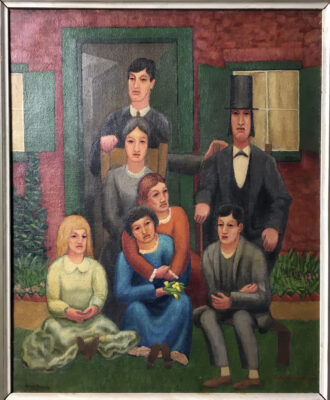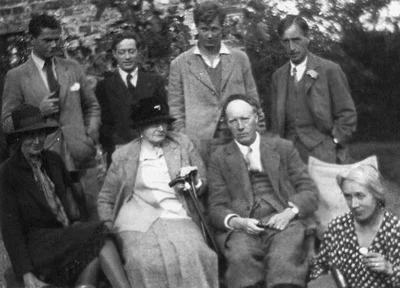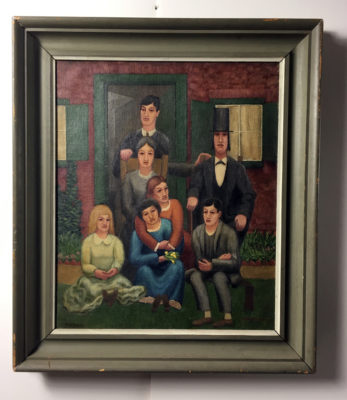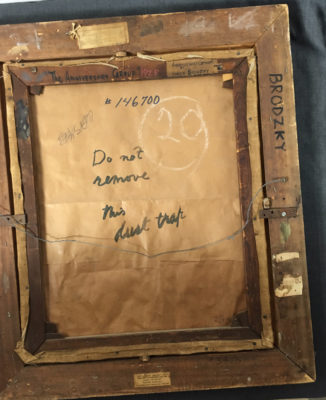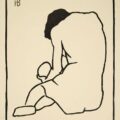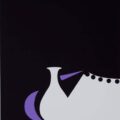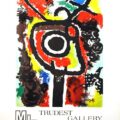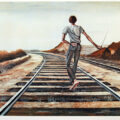This painting has not been properly associated with its source material. Once you know that this is actually a contemporary painting of the Bloomsbury Group, the context of the painting is more understandable. Rather than an a strange and archaic paint of a family reunion, it seems more likely that this is a reverential homage to Brodzky’s artistic and intellectual inspiration he derived from Bloomsbury. This is also evident in his linocuts which echo Vanessa Bell and Roger Fry’s work.

Biography:
Horace Brodzky (1885-1969) was an Australian artist who played an important role in the development of modern art in the 20th century. He was one of the earliest Australian artists to embrace modern styles, and he was the first Australian to exhibit at the Venice Biennale in 1912. Brodzky was a painter, printmaker, and sculptor, and he was particularly known for his linocuts, which he was one of the first artists to seriously involve himself in.
Brodzky was also an intimate friend of many well-known artists of his time, including Henri Gaudier-Brzeska, Jacob Epstein, and David Bomberg. He was a member of the London Group and exhibited widely in Australia and overseas, including many solo and group shows in London where he lived from 1923 until his death.
Brodzky’s works are represented in many important collections, including the British Museum, the Tate Gallery, the Victoria and Albert Museum, and the Museum of Modern Art in New York. His graphics were used to illustrate the literary works of prominent writers such as Ezra Pound, Eugene O’Neill, Upton Sinclair, and Theodore Dreiser.
Brodzky’s approach to art-making was characterized by a spontaneous and intuitive process. He preferred to use a simple steel nib and to make drawings quickly and without preliminary studies, erasures, or alterations. He believed that this approach allowed him to access his subconscious or half-conscious mind and to create works that were truly spontaneous and free.
1885 Born in Kew, Victoria. Son of Australian journalist Maurice Brodsky
1901 Attends the National Gallery School
1905–07 Travels to San Francisco and New York
1906 Enrolls in National Academy of Design, New York
1908 Moves to London
1911 Begins studies at the City and Guilds Art School, Kensington. Here he formed a close association with fellow artists David Bomberg, Henri Gaudier-Brzeska, Jacob Epstein, and Mark Gertler. During this time Brodzky also traveled to Rome, Naples and Sicily with friend and notable American poet John Gould Fletcher, encountering the works of Piero della Francesca who became a major influence on his art
1915-22 Upon the death of good friend Gaudier-Brzeska, Brodzky returns to New York and soon finds work in art journalism and theatre designs. He also continues his painting and printmaking
1920 A portfolio of Brodzky’s linocuts is published by Egmont Arens
1923 Returns and settles in London, England
1929 Brodzky’s work is included in an exhibition of linocuts curated by Claude Flight, Redfern Gallery
1933 Brodzky’s biography of Gaudier-Brzeska is published
1948 Became Art Editor of the Antique Dealer and Collectors Guide
1969 Dies in London, England
Exhibitions: Exhibited widely in Australia and overseas including many group and solo shows in London where he lived from 1923 until his death.
1911 First solo exhibition ‘Paintings and Sketches of Italian and Sicilian Scenes’ held in his own studio in Chelsea. The painting ‘Girgenti – The Pine Tree’ chosen for exhibition in the Venice Biennale
1917 Exhibited in a mixed exhibition of international contemporary masters in New York with Davies, Gaudier-Brzeska, Laurencia, Picasso, Prendergast, Pascin and Vlaminck
1924 Exhibited in combined exhibition ‘Horace Brodzky, Hyam Myer, Jan Juta and Frank Potter’
1928 Exhibited in London Group Retrospective
1929 Exhibited in ‘First Exhibition of British Lino-cuts’
1937 Exhibited in combined exhibition ‘David Bonberg, Margarete Hamerschlag and Horace Brodzky’
1965-67 Retrospective exhibitions in London: Ben Uri Gallery; Oxford Union Cellars; Mercury Gallery and Macy’s Gallery, New York
1972 Exhibited in ‘The Café Royalists’, Michael Parkin Gallery, London, and at the Café Royal
1973-77 Retrospective exhibitions in London: Fieldborne Gallery; Michael Parkin Gallery; Belgrave Gallery; Fieldborne Gallery
1978 Exhibited ‘Jewish Artists of Great Britain (1845-1945)’, Belgrave Gallery, London, and Cartwright Hall Art Gallery and Museum, Bradford
Collections
National Gallery of Australia, Canberra
Most Australian state and many regional gallery and university collections
British Museum, London
Arts Council of Great Britain, London
Ashmolean Museum, Oxford
Tate Gallery, London
Victoria and Albert Museum
National Museum of Wales, Cardiff
Scottish National Gallery of Modern Art, Edinburgh
Numerous regional and university collections throughout Great Britain
Tel Aviv Museum, Israel
Honolulu Academy of Arts, USA
Museum of Modern Art, New York
New York Public Library
Source:
Lew, Henry R., ‘Brodzky’, Dr Henry R. Lew, Melbourne, May 1987
Statement:
“Brodzky prefers the ordinary ‘dip-in’ steel nib, for this enables the hand, by carrying its pressure on the paper, to broaden the line at will, or rather in obedience to the obscure subconscious or half-conscious promptings which guide the hand to its task. He makes no preliminary studies, draws no pencil outline, carefully rubbed out afterwards to give a false impression of spontaneity. There are no erasures or alterations. Each drawing is made ‘au premier coup’. It is made very quickly, as a unity, and when finished the artist cannot remember at what point it was started. The drawing has been thrown on the paper, as it were, with a single gesture”
– James Laver
Publications
40 Drawings by Horace Brodzky, James Laver, illustrated by Horace Brodzky, London: William Heinemann, 1935;
Gaudier-Brzeska by Horace Brodzky, London: Faber & Faber, 1956;
Piscine by Horace Brodzky, London: Nicholson, 1946;
Horace Brodzky by Henry Lew, Australia: Hamlynm, 1981 and James Squire Color Printing, 1987;
Horace Brodsky-Retrospective Exhibition, Catalog, 1988.
Additional Information:
Born: 1877
Birthplace: Melbourne, Australia
Died: 1969, London, England
